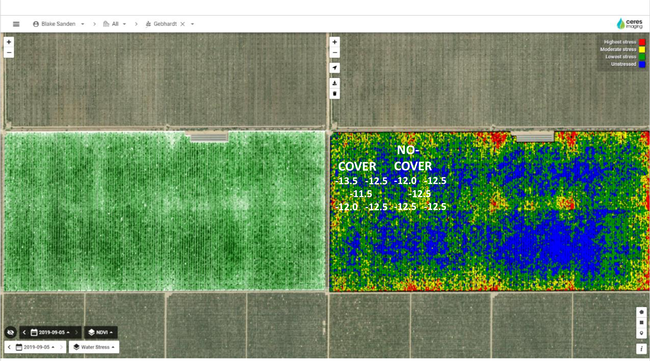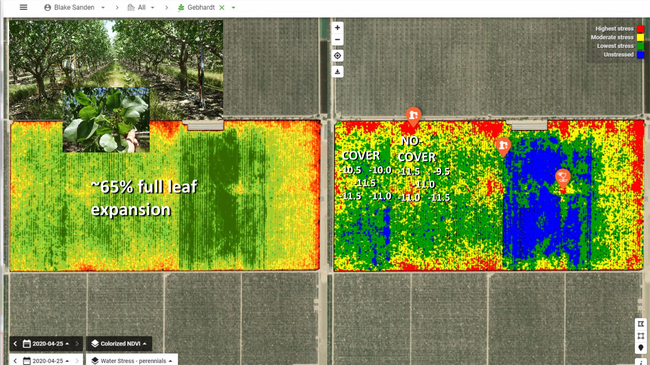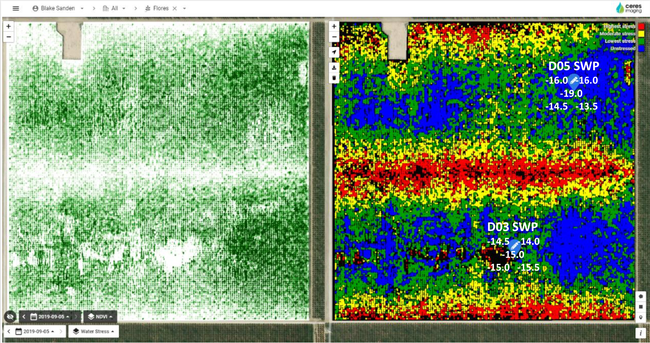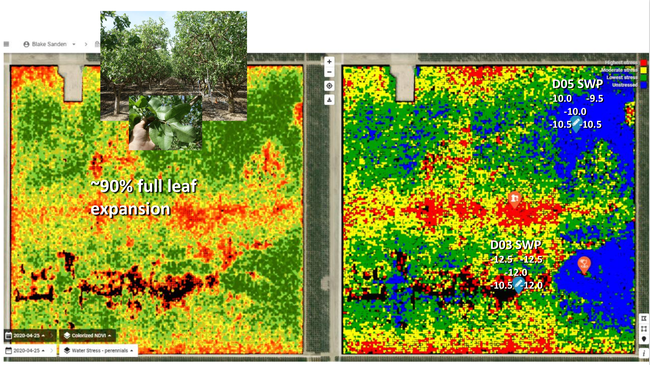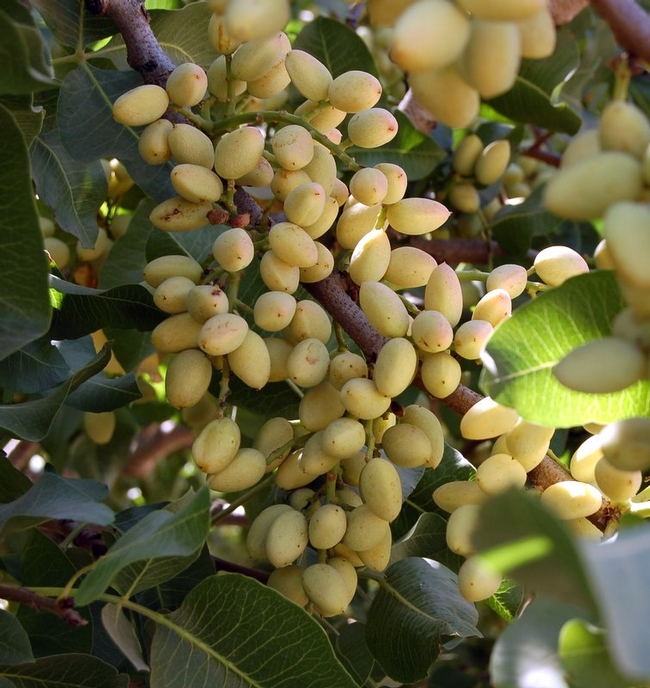
This is the opening BLOG for our 2020 Pistachio Irrigation Demo where we will attempt to put up relevant data and images to help growers see alternative monitoring methods in action over 3 different mature pistachio production orchards from Eastside to Westside, non-saline to saline soils. This DEMO BLOG is intended not only to give you easy to digest summary irrigation management snapshots, but also allow for your feedback/questions which I will attempt to address as time allows. Fortunately, none of these Demo orchards had blanking problems this spring. For a summary of yield, applied water and tree stress (using the pressure chamber to measure stem water potential, SWP) for 2019 go to the above website hosted by the UCD FNRIC.
For this first BLOG we're going to take a quick look at CERES remote sensing aerial imagery of tree water stress (calculated from the canopy temperature as determined by infrared camera) and Normalized Differential Vegetative Index (NDVI, basically a plant volume and vigor estimate calculated from a normalized ratio of near infrared reflectance over the entire infrared spectrum). We will see how the last image just before harvest (9/6/2019) compares with just a couple weeks ago (4/25/2020) and how the in-field ground-based stem water potential (SWP) pressure bomb readings compare. This is where interpreting this kind of imagery gets tricky…
Point 1, NDVI: CERES changed the NDVI color scheme from last year to increase the contrast resolution so the red and yellow now correspond to last year's least green more open areas. Eventually, CERES is going to provide numbers to go with these images, but my eyeball calculator says that the 4/25/2020 NDVI in the Eastside west 80 acres is less than the NDVI in the 9/6/2019 image. This makes sense because as of 4/25 the full leaf expansion was about 75% -- so smaller leaves and no cluster weight pulling branches down like in the 9/6 image means that the trees appear to have a lower density of foliage in the aerial image. This difference is less in the Lemoore saline field as the 4/25 leaf expansion was 90%.
Point 2, Accuracy of Water Stress and relative color scheme: Comparing the Water Stress images (right hand image, all fields) from September to April is like a slap in the face! Your first thought is, “Wow, these fields were not sufficiently pre-irrigated to refill the profile and there is less water in the rootzone then there was right before the 2019 harvest!” But this is not true. Compare the SWP readings I show in white for 9/6 versus 4/25. These ground-based tree readings ran -12 to -19 bars depending on the field and salinity at harvest indicating that stored rootzone water was depleting and creating some stress in the trees (-14 bars is moderate stress). But for 4/25 these numbers are much less negative at -9 to -13 bars, which is what you want to see – no stress during the spring push. But why is there much less blue (least stress color) in the 4/25 image compared to the 9/6 image? Unfortunately, this an artifact of the automatic coloring legend used by CERES and most imaging companies. For any given image they take the coolest pixel temperature and make that range blue. Since they are working with only 4 colors in the legend (blue to red) the program divides the range of canopy temperatures in a given flyover into 4 zones to give you the colorized image. This colorized scheme is an accurate representation of the relative variability in canopy temperature/stress at that time, but it is not an absolute measure of real plant stress, like the SWP number from the pressure bomb, that can be compared across different images. For example, the Eastside 9/6 image may have had an average canopy temperature of 95 F, with the coolest to hottest temps running 93-98 F. Now the 4/25 image was maybe an average temp of 82 F with a range of only 81-83 F. And for this image the coolest area is the SE 40 acres with an actively growing cover crop of Brome grass, so now the western 80 acres gets colored mostly yellow even though it may be only 0.7-1 degree higher canopy temp then the SE 40. This is another reason why it would be helpful to have actual numbers and not just colored pixels for these images.
Point 3, Cover crop interaction: An actively growing cover crop will significantly influence remotely sensed canopy temperature and reflectance of other wavelengths (near infrared, NIR, for example most often associated with chlorophyll content) and can skew the real results from just the trees when you have hedged during the winter and a lot of the drive is visible between the trees. This is very clearly shown in the Eastside location where the Brome grass was planted later and responded vigorously to the 2.5” of rain in early April. This effect was not as pronounced on the Westside field for the Cover vs. No Cover zones as the Brome had been seeded in November and had already set seed and was dying down by 4/25. The bluest (coolest) area in this field was clearly associated with the irrigation set to the east that had come on at 7:00 AM, which is also confusing as I was told that this 300 acre field irrigates in two sets ... And so the blue area should have extended to the eastern edge of the field.
Point 4, Boots on the ground, in-field tree and soil moisture measurements essential: the SWP pressure bomb readings confirmed the lack of stress on the trees despite minimal “blue/no stress” in the CERES images. Hand probing, neutron probe, tensiometers, Sentek Drill & Drop capacitance probes with Jain Logic transmitters and web-based processing all tell us that there is plenty of soil moisture storage. Walking the field and observing good shoot growth and leaf expansion confirm we're on track. Our Phytech dendrometers to measure tree trunk shrink/swell as a direct measure of tree stress are currently functioning at only 2 sites in the Lemoore saline field. We will discuss these other technologies in future BLOGS.
EASTSIDE NON-SALINE Sandy Loam
CERES IMAGING
NDVI & THERMAL WATER STRESS
(9/6/2019, 4/25/2020)
WESTSIDE NON-SALINE Sandy Loam (no cover crop) and Clay Loam (cover crop)
CERES IMAGING
NDVI & THERMAL WATER STRESS
(9/6/2019, 4/25/2020)
LEMOORE SALINE & SEMI-SALINE
Clay Loam
CERES IMAGING
NDVI & THERMAL WATER STRESS
(9/6/2019, 4/25/2020)


